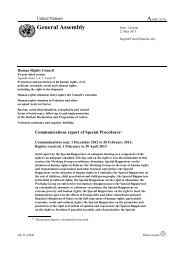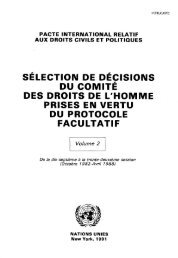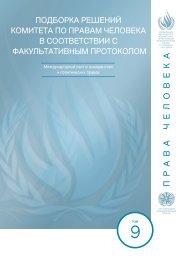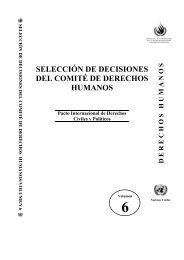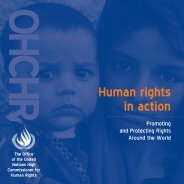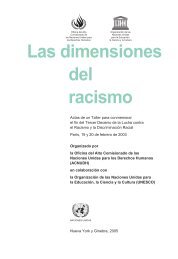good governance practices for the protection of human rights
good governance practices for the protection of human rights
good governance practices for the protection of human rights
You also want an ePaper? Increase the reach of your titles
YUMPU automatically turns print PDFs into web optimized ePapers that Google loves.
E. Municipal re<strong>for</strong>m to combat corruption and improve <strong>the</strong> delivery<br />
<strong>of</strong> services – Bolivia<br />
Issue<br />
In <strong>the</strong> mid-1980s, corruption was rampant in all areas <strong>of</strong> municipal government<br />
in Bolivia’s capital city, La Paz, from delivering services to carrying out public<br />
works, policing <strong>the</strong> public markets, and issuing permits and licences. The widespread<br />
corruption resulted in such institutional decay that municipal authority<br />
had virtually collapsed. The prevalence <strong>of</strong> corruption was exacerbated by <strong>the</strong> fact<br />
that Bolivia was going through a severe economic crisis and that <strong>the</strong> finances <strong>of</strong><br />
cities deteriorated as economic assistance from <strong>the</strong> national Government was cut<br />
and city revenues dried up. In <strong>the</strong> midst <strong>of</strong> <strong>the</strong> economic crisis, <strong>the</strong> salaries <strong>of</strong><br />
La Paz city employees eroded significantly owing to hyperinflation <strong>of</strong> 26,000 per<br />
cent. The city was on <strong>the</strong> verge <strong>of</strong> financial ruin as its monthly payroll exceeded<br />
monthly revenues by 20 per cent.<br />
The decline <strong>of</strong> municipal institutions and <strong>the</strong> corrupt management <strong>of</strong> public resources<br />
compromised <strong>the</strong> municipality’s ability to guarantee <strong>human</strong> <strong>rights</strong>, including<br />
<strong>the</strong> right to health, adequate housing, access to food and quality education.<br />
Response<br />
The comprehensive ef<strong>for</strong>t to combat corruption in La Paz was launched with <strong>the</strong><br />
goal <strong>of</strong> improving <strong>the</strong> delivery <strong>of</strong> municipal services. The deficiencies in service<br />
delivery, in <strong>the</strong> completion <strong>of</strong> public works and in <strong>the</strong> collection <strong>of</strong> revenues<br />
were almost always associated with corruption. Corruption was a systemic problem<br />
ra<strong>the</strong>r than one <strong>of</strong> corrupt individuals. Corruption was deeply ingrained in<br />
<strong>the</strong> political culture <strong>of</strong> <strong>the</strong> city. It was <strong>the</strong>re<strong>for</strong>e important to carry out a comprehensive<br />
re<strong>for</strong>m and to enlist municipal employees in this ef<strong>for</strong>t. Fur<strong>the</strong>rmore, following<br />
decades <strong>of</strong> authoritarian government, a weak civil society and low public<br />
demand <strong>for</strong> anti-corruption ef<strong>for</strong>ts posed challenges to <strong>the</strong> re<strong>for</strong>m movement.<br />
The municipal leadership elected in 1985 embarked on a comprehensive re<strong>for</strong>m<br />
process, which addressed several aspects <strong>of</strong> municipal affairs: corruption in <strong>the</strong><br />
police <strong>for</strong>ce, in <strong>the</strong> public works and construction service <strong>of</strong> <strong>the</strong> municipality, in<br />
procurement, in taxation, and in <strong>the</strong> issuing <strong>of</strong> licences and permits.<br />
Design<br />
In 1985, <strong>the</strong> inhabitants <strong>of</strong> La Paz elected <strong>for</strong> <strong>the</strong> first time in 40 years <strong>the</strong>ir municipal<br />
government. Mayor Ronald MacLean-Abaroa was elected on <strong>the</strong> promise to<br />
improve <strong>the</strong> delivery <strong>of</strong> municipal services. One <strong>of</strong> <strong>the</strong> first steps <strong>of</strong> <strong>the</strong> municipal<br />
government’s anti-corruption policy was to involve municipal employees. Municipal<br />
<strong>of</strong>ficials participated in workshops and discussions in an ef<strong>for</strong>t to diagnose<br />
<strong>the</strong> nature and extent <strong>of</strong> corruption. First, a case study <strong>of</strong> a successful anti-corruption<br />
campaign in ano<strong>the</strong>r country was presented in workshops. Then <strong>the</strong> par-<br />
71



